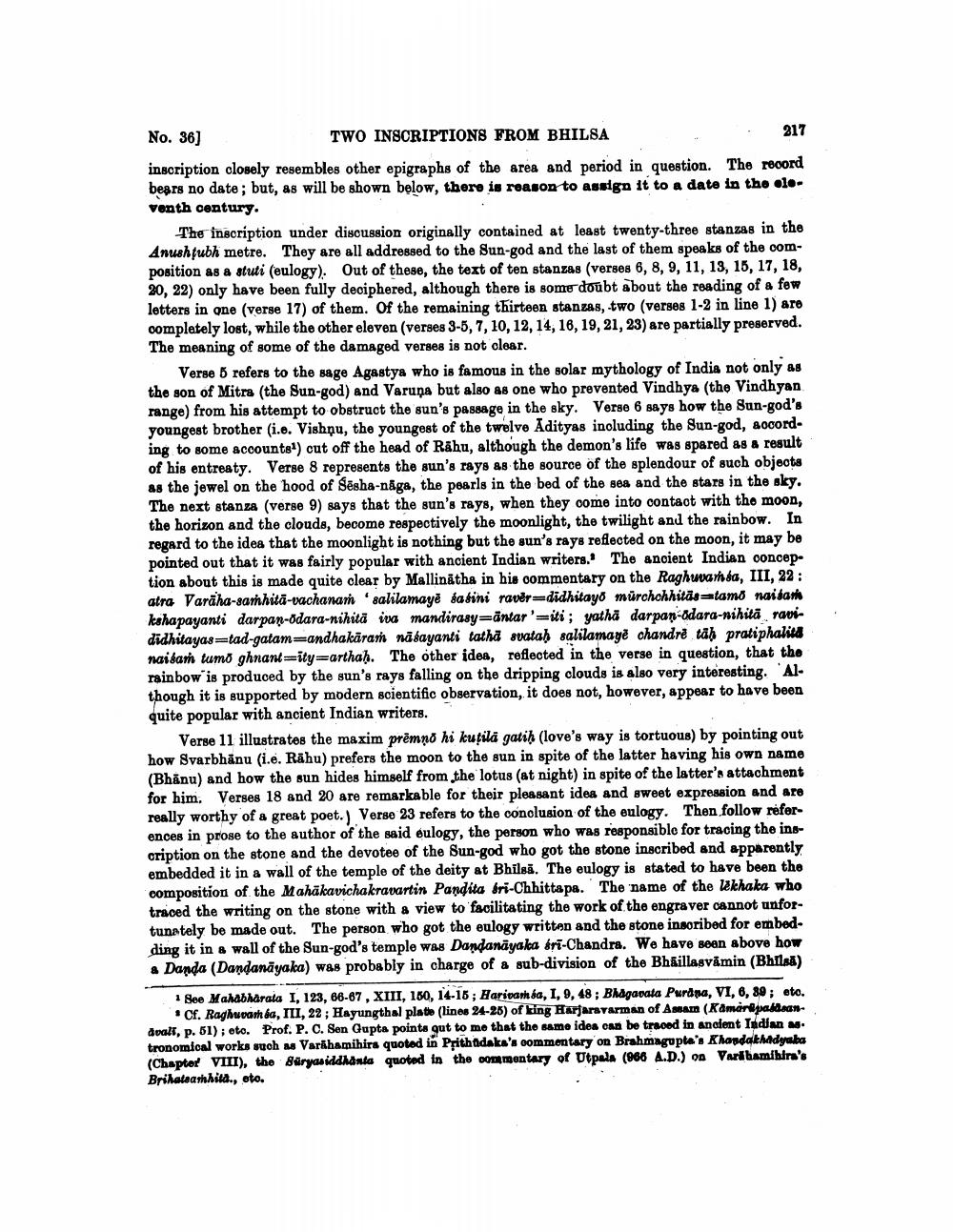________________
No. 36] TWO INSCRIPTIONS FROM BHILSA
. 217 inscription closely resembles other epigraphs of the area and period in question. The record bears no date; but, as will be shown below, there is reason to assign it to a date in the oloventh century.
The inscription under discussion originally contained at least twenty-three stanzas in the Anushtubh metre. They are all addressed to the Sun-god and the last of them speaks of the composition as a stuti (eulogy). Out of these, the text of ten stanzas (verses 6, 8, 9, 11, 13, 15, 17, 18, 20, 22) only have been fully deciphered, although there is some doubt about the reading of a few letters in one (verse 17) of them. Of the remaining thirteen stanzas, two (verses 1-2 in line 1) are completely lost, while the other eleven (verses 3-5, 7, 10, 12, 14, 16, 19, 21, 23) are partially preserved. The meaning of some of the damaged verses is not clear.
Verse 5 refers to the sage Agastya who is famous in the solar mythology of India not only as the son of Mitra (the Sun-god) and Varuņa but also as one who prevented Vindhya (the Vindhyan range) from his attempt to obstruct the sun's passage in the sky. Verse 6 says how the Sun-god's youngest brother (i.e. Vishnu, the youngest of the twelve Adityas inoluding the Sun-god, accord ing to some accounts') cut off the head of Rāhu, although the demon's life was spared as a result of his entreaty. Verse 8 represents the sun's rays as the source of the splendour of such objects as the jewel on the hood of Sēsha-nāga, the pearls in the bed of the sea and the stars in the sky. The next stanza (verse 9) says that the sun's rays, when they come into contact with the moon, the horizon and the clouds, become respectively the moonlight, the twilight and the rainbow. In regard to the idea that the moonlight is nothing but the sun's rays reflected on the moon, it may be pointed out that it was fairly popular with ancient Indian writers. The ancient Indian conception about this is made quite clear by Mallinātha in his oommentary on the Raghuwarida, III, 22 : atra Varaha-sanhita-vachanamh 'salilamaye sasini ravérdidhitayo mürohohhitäsatamo naisari kshapayanti darpan-odara-nihita iva mandirasy=āntar'iti; yatha darpan-odara-nihitä ravididhitayas-tad-gatam-andhakaran nākayanti tatha svatah salilamaye chandre tab pratiphalit naisaṁ tumo ghnant=ity=arthah. The other idea, reflected in the verse in question, that the rainbow is produced by the sun's rays falling on the dripping clouds is also very interesting. Although it is supported by modern scientific observation, it does not, however, appear to have been quite popular with ancient Indian writers.
Verse 11 illustrates the maxim prēmno hi kutila gatih (love's way is tortuous) by pointing out how Svarbhānu (i.e. Rāhu) prefers the moon to the sun in spite of the latter having his own name (Bhanu) and how the sun hides himself from the lotus (at night) in spite of the latter's attachment for him. Verses 18 and 20 are remarkable for their pleasant idea and sweet expression and are really worthy of a great poet. Verse 23 refers to the conolusion of the eulogy. Then follow references in prose to the author of the said eulogy, the person who was responsible for tracing the inscription on the stone and the devotee of the Sun-god who got the stone inscribed and apparently embedded it in a wall of the temple of the deity at Bhilsā. The eulogy is stated to have been the composition of the Mahakavichakravartin Pandita Sri-Chhittapa. The name of the lekhaka who traced the writing on the stone with a view to facilitating the work of the engraver cannot unfortunately be made out. The person who got the eulogy written and the stone insoribed for embed ding it in a wall of the Sun-god's temple was Dandanayaka bri-Chandra. We have seen above how a Danda (Dandanayaka) was probably in charge of a sub-division of the Bhaillasvåmin (Bhtisa)
See Mahabharata I, 123, 66-67, XIII, 160, 14-16; Harivansa, I, 9, 48 ; Bhagavata Purdpa, VI, 6, 89; eto.
* Cf. Raghuvarba, III, 22 ; Hayungthal plato (lines 24-26) of king Harfars varman of Asam (Kamaripaddaandvall, p. 51); oto. Prof. P. C. Sen Gupta points out to me that the same idea can be traced in ancient Indian ns. tronomical works such as Varkhamihirs quoted in Prithdaks's commentary on Brahmagupta's Khandakhadya.ba (Chapter VIII), the Süryasiddhanta quoted in the commentary of Utpala (966 A.D.) on Varibamibia's Brihataamhita., ato.




